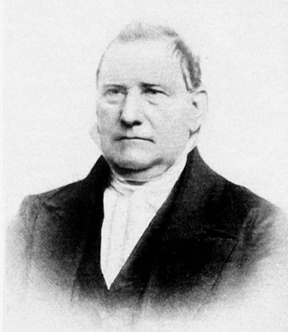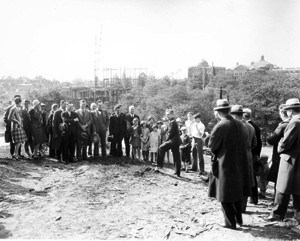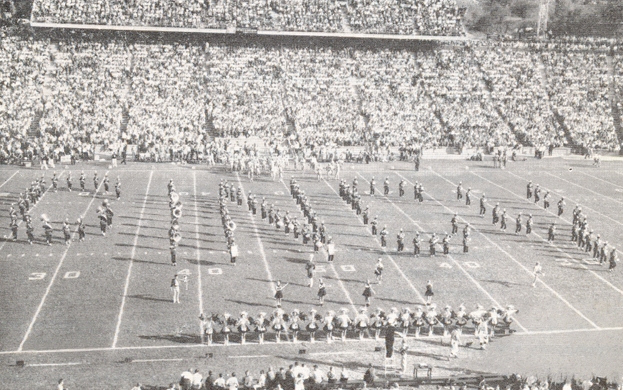This past Tuesday when Professor Richard Schade was examining early Cincinnati German newspapers in the Archives & Rare Books Library, he came across an interesting item: a notice about Charles McMicken’s will in the April 1858 issue of Protestantische Zeitblatter. Considered the founder of the University of Cincinnati, McMicken died of pneumonia on March 30, 1858. His will stipulated a bequest to the City of Cincinnati to found a university, and after several fits and starts, UC was officially established in 1870. Continue reading
Tag Archives: uc history
An Unexpected View of Blegen Library
Two years ago when CCM Librarian Mark Palkovic worked with a UC architecture seminar on historic preservation on projects that created designs for an academic music library, there was an unexpected bonus for the University Archives. The students’ projects centered on using the abandoned University YMCA building at the south end of campus to imagine its adaptive reuse as a library and performance space. Continue reading
Libraries Awarded NEH Grant to Digitize the Correspondence and Photographs of Albert B. Sabin
 The University of Cincinnati Libraries have received a $314,258 grant from the National Endowment for the Humanities (NEH) to digitize the correspondence and photographs of Albert B. Sabin, developer of the oral polio vaccine and distinguished service professor at the University of Cincinnati College of Medicine and Children’s Hospital Research Foundation from 1939-1969.
The University of Cincinnati Libraries have received a $314,258 grant from the National Endowment for the Humanities (NEH) to digitize the correspondence and photographs of Albert B. Sabin, developer of the oral polio vaccine and distinguished service professor at the University of Cincinnati College of Medicine and Children’s Hospital Research Foundation from 1939-1969.
The primary source documents to be digitized include 35,000 letters totaling 50,000 pages of correspondence between Sabin and political, cultural, social, and scientific leaders around the world. Also included will be 1,000 photographs documenting the events and activities worldwide that were part of Sabin’s crusade to eradicate polio.
Spring 2010 Records Quarterly Now Available
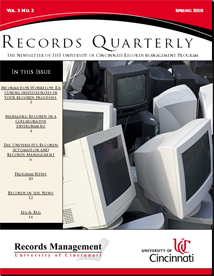 The Spring 2010 edition of Records Quarterly, the newsletter of University of Cincinnati Records Management, is now available on the records management website at http://www.libraries.uc.edu/libraries/arb/records_management/recordsquarterly.html. This issue includes articles about how you can improve your workflow processes and things you need to consider when creating records in a collaborative environment, such as committee work. Additionally, the final installment of our series on the history of records at UC takes us from the beginning of automated records processes in 1949 to the present.
The Spring 2010 edition of Records Quarterly, the newsletter of University of Cincinnati Records Management, is now available on the records management website at http://www.libraries.uc.edu/libraries/arb/records_management/recordsquarterly.html. This issue includes articles about how you can improve your workflow processes and things you need to consider when creating records in a collaborative environment, such as committee work. Additionally, the final installment of our series on the history of records at UC takes us from the beginning of automated records processes in 1949 to the present.
Records Quarterly is distributed electronically via the Records Management website. Subscribers to the Records Management Listserv will receive notification of new issues automatically. You can sign up for the listserv by going to the subscription page at https://listserv.uc.edu/cgi-bin/wa.exe?A0=LIB-RECMGMT, or by sending an email to Janice.Schulz@uc.edu. Please include your name and email address and use “listserv sign-up” in the subject line.
– Janice Schulz
Protest! The Campus and Reaction Against War
 In May 1970 the University of Cincinnati closed its doors to students and canceled classes. Campus demonstrations over the escalating Vietnam War and the invasion of Cambodia, the deaths of protesters at Kent State University and Jackson State University, and discontent with the administration’s efforts in enfranchising African American students led to the occupation of Van Wormer Hall and Beecher Hall. UC came to a standstill as students, faculty, staff, and administrators grappled with the issues of world turmoil being faced at the university. Continue reading
In May 1970 the University of Cincinnati closed its doors to students and canceled classes. Campus demonstrations over the escalating Vietnam War and the invasion of Cambodia, the deaths of protesters at Kent State University and Jackson State University, and discontent with the administration’s efforts in enfranchising African American students led to the occupation of Van Wormer Hall and Beecher Hall. UC came to a standstill as students, faculty, staff, and administrators grappled with the issues of world turmoil being faced at the university. Continue reading
Poor Pearl, Poor Girl! The Awful Story of the Murder of Pearl Bryan
 One hundred thirteen years ago, two UC dental students were executed by hanging. Yes, it’s true: the University of Cincinnati once had a dental school. It was the Ohio College of Dental Surgery and from 1888 to 1906, and then again from 1923 to its closing in 1926, the dental college was part of the university. Cincinnati had a distinct shortage of dentists in the early years of the 19th century – there were only two in 1830. The Ohio College of Dental Surgery was founded in 1845, and just a few short years after that, the Queen City boasted a directory of over forty dentists. The school attracted students from around the Midwest and was the first dental college to graduate a woman, one Lucy Hobbs of McGregor, Iowa. It was the custom of the college’s faculty in those days to send each student out into the world equipped with both a diploma and a Bible. There are, after all, many kinds of cavities to fill in day-to-day existence. The college’s later affiliation with the University of Cincinnati was a reflection of the number of medicine-oriented schools in 19th century Cincinnati that strived to combine classroom instruction with practical experience. Continue reading
One hundred thirteen years ago, two UC dental students were executed by hanging. Yes, it’s true: the University of Cincinnati once had a dental school. It was the Ohio College of Dental Surgery and from 1888 to 1906, and then again from 1923 to its closing in 1926, the dental college was part of the university. Cincinnati had a distinct shortage of dentists in the early years of the 19th century – there were only two in 1830. The Ohio College of Dental Surgery was founded in 1845, and just a few short years after that, the Queen City boasted a directory of over forty dentists. The school attracted students from around the Midwest and was the first dental college to graduate a woman, one Lucy Hobbs of McGregor, Iowa. It was the custom of the college’s faculty in those days to send each student out into the world equipped with both a diploma and a Bible. There are, after all, many kinds of cavities to fill in day-to-day existence. The college’s later affiliation with the University of Cincinnati was a reflection of the number of medicine-oriented schools in 19th century Cincinnati that strived to combine classroom instruction with practical experience. Continue reading
Former President Nancy Zimpher's Papers in the University Archives
The Office of the President recently transferred nineteen boxes of papers from former UC President Nancy Zimpher for inclusion in the University Archives Collection. President Zimpher, UC’s first woman president, served the University from October 2003 to May 2009, when she resigned to become Chancellor of the State University of New York system.
The new collection, accessioned as UA-10-01, mainly consists of the hundreds of speeches that President Zimpher made between 2004 and 2007. She was a popular sought-after speaker, averaging one speech a day to both campus groups and outside organizations. Also included are subject files from her work with The Coalition of Urban Serving Universities and The Brookings Institute, as well as various publications from 2005-2009.
The Archives holds two other collections of President Zimpher’s papers as well: Collection Number UA-09-24 contains calendars from 2003-2009, and Collection Number UA-06-07 contains office files from 2003-2006. Finding aids for all of the collections can be found on the Archives & Rare Books Library website at http://www.libraries.uc.edu/libraries/arb/archives/collections/UACollectionRecords.html.
– Janice Schulz
Ever Wonder Where UC's President Lives?
When the University of Cincinnati was created in 1870, it was as a municipal university, and, it was always considered to be a “university of the city.” This philosophy – that the university would draw from the city’s rich, vibrant resources of culture and business, and in turn render service to the city through its students and educational programs – meant that the university’s leaders would be “of the city” as well. Continue reading
Bearcat Bands in the University Archives
The Archives and Rare Books Library recently processed a new collection of records documenting activities of the University of Cincinnati Bearcat Bands from 1954 to 1996. The records are part of the University Archives through the UC Band Alumni Association. Operating as a department within the Division of Student Life, UC Bearcat Bands provides students of all majors with opportunities for performing musically while obtaining fine arts credit. The UC Band Alumni Association provides alumni opportunities to stay connected with UC Bearcat Bands and other alumni after graduation. Alumni members can also participate in the Community/Alumni Band. Continue reading
Tribute to a Champion
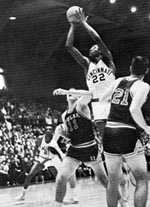 Paul Hogue, one of the greatest athletes in the University of Cincinnati’s history, and a member of the school’s NCAA championship teams in 1961 and 1962, passed away in Cincinnati on August 17, 2009 at the age of 69.
Paul Hogue, one of the greatest athletes in the University of Cincinnati’s history, and a member of the school’s NCAA championship teams in 1961 and 1962, passed away in Cincinnati on August 17, 2009 at the age of 69.
As a tribute to Paul, the Archives and Rare Books Library has created an online exhibit sharing images of him from his remarkable Bearcat career.
From the exhibit: “Paul Hogue was UC’s first truly effective big man who was variously measured at 6’ 9” or 6’ 10 inches tall, a veritable oak on the court as he set picks and cleared the lane for his teammates. Running into a Hogue pick was a memorable experience for opposing players. His offense, coupled with a nice soft shooting touch, made him a collegiate star.”
See more online.

